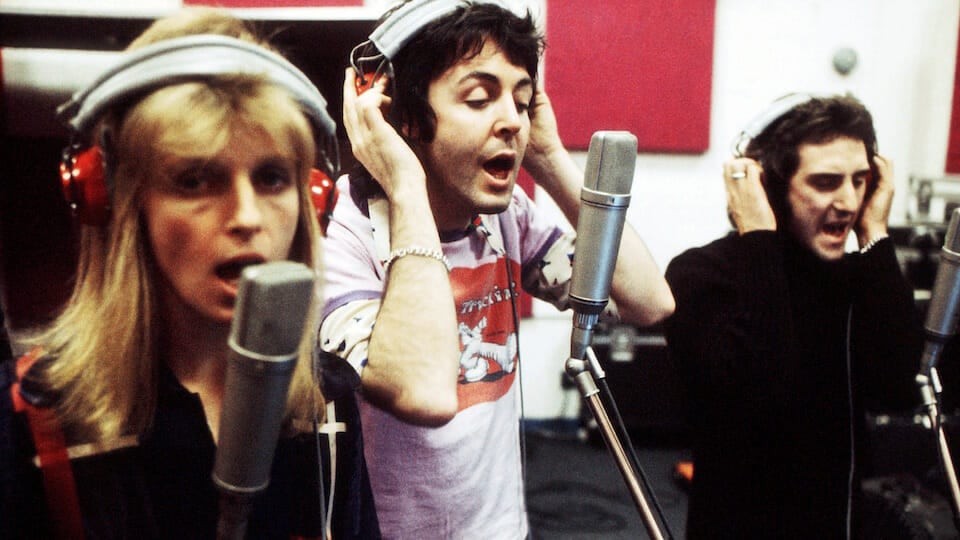On July 9, 1972, Wings embarked upon their first formal concert tour as a working rock ‘n’ roll band. The 25-show tour was an auspicious venture for Paul McCartney’s new group in comparison with Wings’ February barnstorming jaunt across a smattering of British colleges and universities.
Related: “The 10 Best Paul McCartney Songs You May Have Never Heard”
By the time that they alighted on their “Wings Over Europe” tour in July 1972, the band was barely a year old. The previous fall—after recording the tracks that would comprise their first LP—they had to come up with a suitable handle. In September 1971, with wife Linda and former Moody Blues member Denny Laine in tow, McCartney set about the business of naming his new band.
As McCartney later joked, “We were thinking of all sorts of names. We had a new group and we had to think of a name. We had a letter from an old gentleman in Scotland, which said, ‘Dear Paul, I see you are looking for a name for your group. I’d like to suggest the Dazzlers.’ So we were nearly the Dazzlers, with the big sequined jackets. But we thought, no, we need something a little more earthy, so we thought of Turpentine. But I wrote to the guy in Scotland and told him that and he wrote back, ‘I don’t think you’ll be calling yourselves Turpentine because that’s something used to clean paint off,’ so we thought of Wings.”
Years later, McCartney would admit that the name found its genesis in more daunting origins. As it happened, the birth of Paul and Linda’s second child Stella was “a bit of a drama.” Complications during her birth nearly resulted in both Linda and Stella’s deaths, prompting McCartney to pray for their survival. At that moment, the image of an angel’s wings came to mind.
Recorded earlier that year, during the summer of 1971, Wings’ first album Wild Life was, by any measure, a homespun rush job. The band’s lineup had come together rather quickly, with McCartney on lead vocals and bass, wife Linda doing her damnedest to fake it ‘till she could make it as a keyboard player, Laine on guitar, and Denny Seiwell, one of McCartney’s Ram sidemen, on drums. The makeshift quartet would mark the beginning of three major lineup shifts over the next several years, with various side musicians clustering around the mainstay nucleus of the McCartneys and the ever-faithful Laine.
Released in December 1971, Wild Life landed a Top 10 showing on the US album charts—a modest result by McCartney’s standards with the Beatles and his first two solo LPs. By the next year, when it came time to hit the road in support of his new band, McCartney set up the band’s European road trip in fine style, having procured a multicolored, double-decker bus for the occasion.
“We knew we were going to tour in Europe, and that the weather would be nice, and the idea of being stuck in a bus all the time, going from city to city, hotel to hotel, wasn’t too appealing,” McCartney later recalled. “So we decided to travel around in an open-top bus and got some sunshine as we traveled from one place to another. And we painted the outside psychedelic, like a magic bus. If you look at it very straight, very conventionally, it was quite a mad thing to do, to put a playpen on the top deck of the bus and put all the children in there while driving around Europe. It was not what you’d expect from a normal band. But we weren’t a normal band.”
The Wings Over Europe tour commenced with a performance at the Châteauvallon in Ollioules, France. Not surprisingly, audiences came out in droves for the shows—after all, how often do you get to see a bona fide ex-Beatle in smallish venues like the Châteauvallon and, later, Amsterdam’s Concertgebouw? As the surviving recordings demonstrate, the band was loose and in great spirits. In addition to knocking out rock ‘n’ roll covers like “Blue Moon of Kentucky” and “Long Tall Sally,” the group’s setlist included early McCartney solo gems such as “Maybe I’m Amazed” and “Smile Away.”
Years later, McCartney would remember his years with Wings with a special fondness. “Looking back on it,” he recently admitted, “I’m really glad we did it.” But of all people, it was John Lennon who understood Wings’ value even more implicitly than its founder. As he observed in one of his final interviews, “I kind of admire the way Paul started back from scratch, forming a new band, and playing in small dance halls, because that’s what he wanted to do with the Beatles—he wanted us to go back to the dance halls and experience that again.” As much as anyone, Lennon perceived the sheer amount of risk inherent in creating a band out of whole cloth in the wake of the Beatles’ juggernaut.
-Ken Womack is an internationally renowned Beatles authority regarding the band’s enduring artistic influence. He is the author, most recently, of Maximum Volume: The Life of Beatles Producer George Martin (The Early Years: 1926-1966) and Sound Pictures: The Life of Beatles Producer George Martin (The Later Years, 1966-2016). His next book, Solid State: The Story of Abbey Road and the End of the Beatles, is forthcoming in September 2019. You can learn more about Ken’s work at kennethwomack.com.
Photo: Linda McCartney, Paul McCartney and Denny Laine of Wings, November 1973. (Michael Putland/Getty Images)




Don’t forget that Paul was influenced by the Merry Pranksters and their Magic Bus, which became the idea for MMT. …I guess Paul must have a thing for busses…”…found my coat and grabbed my hat, made the bus in seconds flat…”